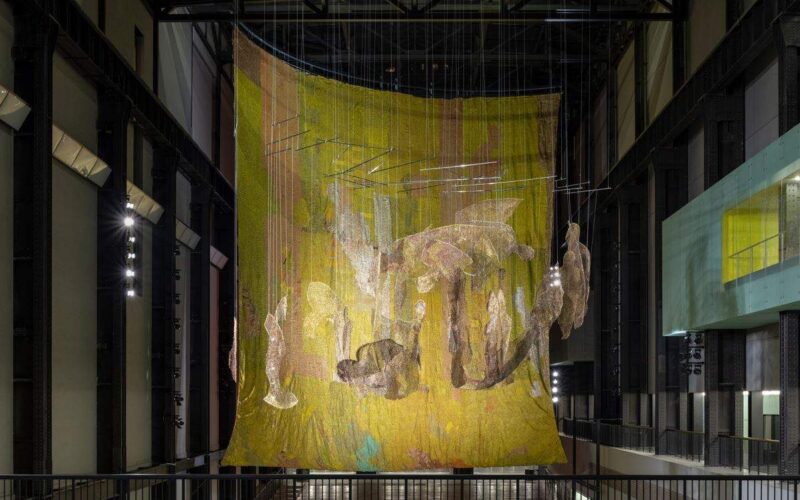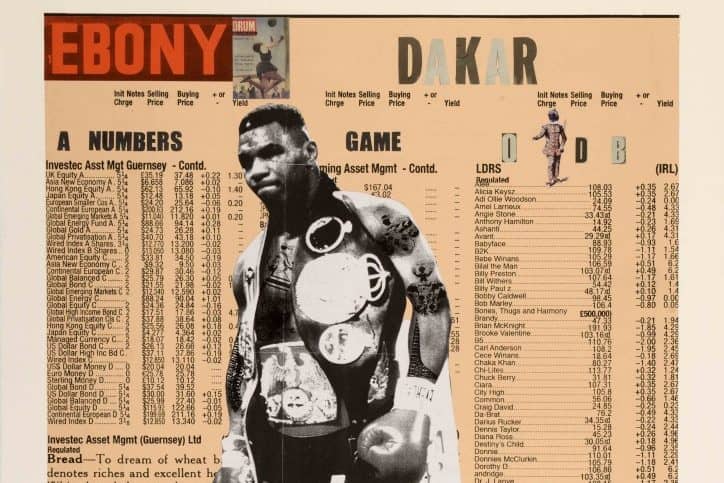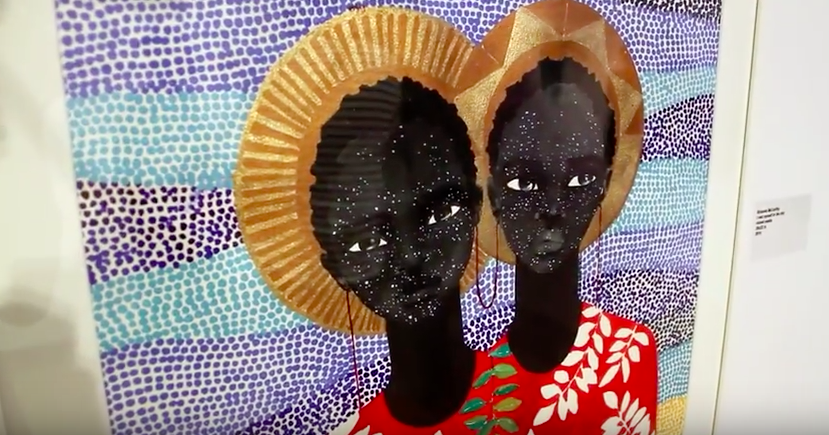From remarkable prize announcements in the visual arts and literature to exciting exhibitions in London, This Week in African Art features artists and writers, including El Anatsui from Ghana, Otobong Nkanga from Nigeria, René Tavares from Sao Tome and Principe, Keabetswe Molotsi from Motswana, Fiston Mwanza Mujila and Logan February —who are from Democratic Republic of Congo and Nigeria respectively. Delve into the details of this round-up to read their news …
Otobong Nkanga Announced Winner of 2025 Nasher Prize
The Nasher Sculpture Center, Dallas has awarded artist Otobong Nkanga its Nasher Prize. The award comes with $100,000 and an exhibition, opening in April 2025, at its museum.
Nasher Sculpture Center Director Jeremy Strick described Nkanga’s works, saying,
“The work of Otobong Nkanga makes manifest the myriad connections—historical, sociological, economic, cultural, and spiritual—that we have to the materials that comprise our lives … Delving deeply into the variegated meanings these materials take on, Nkanga’s work makes clear the essential place of sculpture in contemporary life.”
Born in Kano, Nigeria in 1974, Otobong Nkanga grew up in Lagos, Nigeria and Paris and now lives and works in Antwerp, Belgium. She uses a broad range of materials and weaves together powerful works that delve into the complex, often fragile relationships between humans, the land and its resources, touching on issues of consumption, global circulation, connectivity and care. For over 20 years, she has been producing striking works that explore themes of migration, reflecting her own movement in the world.
The jury for this year’s edition of the prize includes Nairy Baghramian (artist / Germany), Pablo León de la Barra (Guggenheim curator at large, Latin America / Brazil), Carolyn Christov-Bakargiev (director of Castello di Rivoli Museo d’Arte Contemporanea / Italy), Lynne Cooke (senior curator, National Gallery of Art, Washington, D.C. / U.S.), Briony Fer (art historian and critic / U.K.), Hou Hanru (artistic director, MAXXI / Italy), Yuko Hasegawa (director, 21st Century Museum of Contemporary Art, Kanazawa / Japan), Rashid Johnson (artist / U.S.) and Nicholas Serota (chairman of Arts Council England / U.K.).
Portraits for English To See: A Solo Exhibition by René Tavares in London
There is a captivating solo exhibition by René Tavares at the Africa Centre, London. It is titled Portraits for the English to See. Curated by Paula Nascimento, winner of the 2013 Golden Lion for Best National Participation at the Venice Biennale, the exhibition presents six new works.
The works, part of René Tavares’ most recent and iconic painting series—Portraits for English to See and “Cotton People Reloaded”—result from a production and research process that crosses the fields of archive photography and painting.
The title comes from an old Portuguese idiomatic expression, “for English to see,” which appeared in Brazil in the 1830s when England called on that country to enact legislation to stop the slave trade. Unfortunately, the regulatory measures passed at the time had an insignificant impact. However, the expression persisted over time as a synonym of superficiality, being rescued with this same meaning by the artist to highlight themes deeply interconnected with historical and socio-political issues that shaped the construction of several African nations.
By questioning assimilated, neglected and forgotten legacies and by challenging the rigidity of categories and prejudices, René Tavares aims, through his work, to increase awareness and trigger processes of resilience and social empowerment.
The series presented in this exhibition stands out for their grand scale and the skillful manipulation of paints and powdered pigments, with which the artist creates landscapes with cotton fields and malleable surfaces, which often take on an earthy appearance. The persistence of the concept of layer and the idea of miscegenation defines the capital structure of René Tavares’ work, where the artist repeatedly introduces apparent conceptual combinations, crossed cultural and heritage references and composite plastic solutions.
René Tavares occupies a central position in the artistic panorama of São Tomé and is a prominent figure in the contemporary art system in the Portuguese-speaking geographic space. Its visibility has grown in Africa and internationally over the past few years.
As part of the presentation of this exhibition, on Oct. 13, The Africa Center hosted a conversation with the artist entitled Unfinished Histories. The event constituted a unique opportunity to meet René Tavares and to deepen knowledge about the central elements of his artistic practice, as well as interact with some of the most relevant and influential curatorial and cultural voices working with Africa and the creative scene of its diaspora: Angolan architect and curator Paula Nascimento participated as a speaker, and independent curator, British academic and researcher Paul Goodwin served as moderator.
The exhibition will be on view from Oct. 9-29, 2023 at The Africa Center.
El Anatsui’s Monumental Sculpture Behind the Red Moon at Tate Modern
Ghanaian artist El Anatsui recently unveiled his latest monumental sculpture, commissioned by Hyundai, at Tate Modern, London titled Behind the Red Moon. Anatsui is renowned for his metallic sculptures constructed from thousands of recycled bottle tops; this massive cascading work fuses local aesthetic traditions with the global history of abstraction as well as political, social and environmental concerns around consumption, national identity and trade.
The commission builds on Anatsui’s interest in histories of encounters and the migration of goods and people during the transatlantic slave trade. Sourced in Nigeria, the liquor bottle tops used in this commission form part of a present-day industry built on colonial trade routes.
Behind the Red Moon is staged as an artwork in three acts. Visitors are invited to embark on a journey of movement and interaction through the hangings, a dance between bodies and sculptures.
When one sees the hangings from afar, a landscape of symbols is revealed: the moon, the sail, the wave, the earth and the wall. Up close, the bottle tops’ logos speak to the material’s social lives as commodities of a global industry built on colonial trade routes. Together, the past and present of Africa and Europe merge into sculptural forms that hang in the air and appear to float across the space. The hangings embody Anatsui’s idea of the “non-fixed form” and are part of his highly experimental approach to sculpture.
Anatsui engages with the poetic possibilities of his materials. ”Each material has its properties, physical and even spiritual,“ he explained. Behind the Red Moon explores elemental forces interwoven with human histories of power, oppression, dispersion and survival.
Botswana Writer Keabetswe Molotsi Wins the 2023 Kendeka Prize for African Literature
Botswana writer Keabetswe Molotsi has been announced as the winner of the 2023 Kendeka Prize for African Literature for her story, Matlhalerwa. Hussani Abdulrahim from Nigeria was announced as the first runner-up for his story, We Came for Mangoes, while Shedrack Opeyemi Akanbi, also from Nigeria, became the second runners-up for his story, The Lance Corporal’s Door.
The Kendeka Prize for African Literature, founded by Kenyan writer Andrew Maina, aims to encourage Africans to write and read more. It is awarded to the best unpublished fiction or creative non-fiction short story. The first prize is Kshs 100,000 (U.S. $677.); the second and the third prizes are Kshs 50,000 (U.S. $338.) and 25,000 (U.S. $170.) respectively.
The three winning stories were selected from a shortlist of six by a panel of three judges: Zambian writer Natasha Omokhodion-Kalulu Banda, chair, Nigerian author Richard Ali and Kenyan writer Pasomi Mucha. The winners were chosen among entries from 25 African nations.
Keabetswe Molotsi is a Motswana (person from Botswana) writer, artist and English teacher. She has been teaching in a secondary school for over seven years. Keabetswe initially graduated from the University of Botswana with a bachelor of laws degree, but changed careers to pursue teaching. Today, her focus is on a collection of short stories and self-publishing her poetry book.
Fiston Mwanza Mujila, Logan February Named DAAD Berlin Artists-in-Residence
Fiston Mwanza Mujila (Nigeria) and Logan February (DR Congo / Austria) are among the artists in the DAAD Artists-in-Berlin Program for 2024. The DAAD Artists-in-Berlin Program has awarded internationally highly regarded fellowships since 1963. Over 1,000 outstanding international visual artists, authors, filmmakers, composers and sound artists have been invited to live and work in Berlin.
As part of its long-term support of artists, works by current and former guests are presented at the daadgalerie in Kreuzberg and partner institutions in Berlin, around Germany and abroad. Some of the previous African and diaspora residents of this program have been Petina Gappah, Helon Habila, Binyavanga Wainaina, Niq Mhlongo, Yvonne Adhiambo Owuor, Jennifer Nansubuga Makumbi, Maaza Mengiste and many others.
Selecting the fellows for 2024 were Ricardo Domeneck (poet and literary critic), Dr. Maha El Hissy (literary scholar), David Hugendick (literary critic, ZEIT ONLINE), Rike Scheffler (poet, performer and musician), Samir Sellami (literary scholar and critic) and Uljana Wolf (poet and translator).
Logan February is a Nigerian poet and essayist who authored the poetry collections Fuckboys (2021) and In The Nude (2019).
Fiston Mwanza Mujila, a novelist, poet and festival curator, was born in Lubumbashi, Democratic Republic of Congo and lives in Graz, Austria. His multi award-winning debut novel, Tram 83 won the German International Literature Prize, the Rosegger Literary Prize, the Etisalat Prize for Literature and was longlisted and shortlisted for many others. His second novel, La Danse du Vilain, was published in 2021. In addition to his diverse writing activities, he teaches African literature at the University of Graz and acts as a curator for various projects.
Compiled by Roli O’tsemaye











